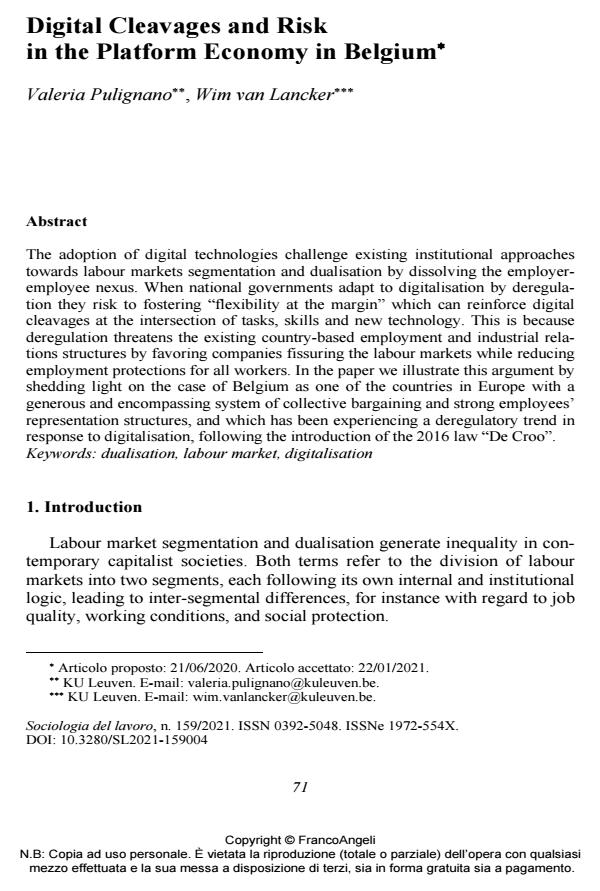Digital Cleavages and Risk in the Platform Economy in Belgium
Titolo Rivista SOCIOLOGIA DEL LAVORO
Autori/Curatori Valeria Pulignano, Wim van Lancker
Anno di pubblicazione 2021 Fascicolo 2021/159
Lingua Inglese Numero pagine 18 P. 71-88 Dimensione file 225 KB
DOI 10.3280/SL2021-159004
Il DOI è il codice a barre della proprietà intellettuale: per saperne di più
clicca qui
Qui sotto puoi vedere in anteprima la prima pagina di questo articolo.
Se questo articolo ti interessa, lo puoi acquistare (e scaricare in formato pdf) seguendo le facili indicazioni per acquistare il download credit. Acquista Download Credits per scaricare questo Articolo in formato PDF

FrancoAngeli è membro della Publishers International Linking Association, Inc (PILA)associazione indipendente e non profit per facilitare (attraverso i servizi tecnologici implementati da CrossRef.org) l’accesso degli studiosi ai contenuti digitali nelle pubblicazioni professionali e scientifiche
The adoption of digital technologies challenge existing institutional approaches towards labour markets segmentation and dualisation by dissolving the employer-employee nexus. When national governments adapt to digitalisation by deregula-tion they risk to fostering "flexibility at the margin" which can reinforce digital cleavages at the intersection of tasks, skills and new technology. This is because deregulation threatens the existing country-based employment and industrial rela-tions structures by favoring companies fissuring the labour markets while reducing employment protections for all workers. In the paper we illustrate this argument by shedding light on the case of Belgium as one of the countries in Europe with a gen-erous and encompassing system of collective bargaining and strong employees’ representation structures, and which has been experiencing a deregulatory trend in response to digitalisation, following the introduction of the 2016 law "De Croo".
L’adozione delle tecnologie digitali sfida gli approcci istituzionali esistenti verso la segmentazione e la dualizzazione del mercato del lavoro, sciogliendo il nesso tra datore di lavoro e dipendente. Quando i governi nazionali si adattano alla digitalizzazione attraverso la deregolamentazione, rischiano di favorire una "flessibilità al margine" che può rafforzare le scissioni digitali all’intersezione di compiti, competenze e nuove tecnologie. Questo perché la deregolamentazione minaccia le strutture occupazionali e di relazioni industriali esistenti a livello nazionale, favorendo le aziende che fissano i mercati del lavoro e riducendo al contempo le tutele occupazionali per tutti i lavoratori. Nel documento illustriamo questo argomento facendo luce sul caso del Belgio come uno dei paesi europei con un sistema di contrattazione collettiva generoso e completo e con forti strutture di rappresentanza dei lavoratori, che sta vivendo una tendenza alla deregolamentazione in risposta alla digitalizzazione, in seguito all’introduzione della legge del 2016 "De Croo".
Parole chiave:Dualizzazione, mercato del lavoro, digitalizzazione, Belgio, legge De Croo
- Digital labour and welfare regimes: The impact of the institutional context on the prevalence of platform work Wouter Zwysen, Bianca Luna Fabris, in Competition & Change 10245294251349484/2025
DOI: 10.1177/10245294251349484 - Digital work across the divide: Japan’s platform economy and labour market dualisation Deborah Giustini, in Contemporary Japan /2025 pp.3
DOI: 10.1080/18692729.2023.2206339
Valeria Pulignano, Wim van Lancker, Digital Cleavages and Risk in the Platform Economy in Belgium in "SOCIOLOGIA DEL LAVORO " 159/2021, pp 71-88, DOI: 10.3280/SL2021-159004